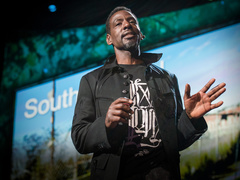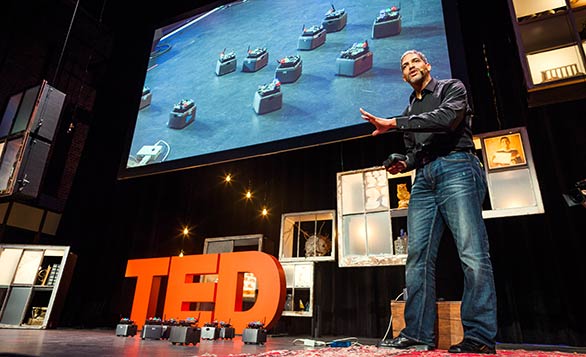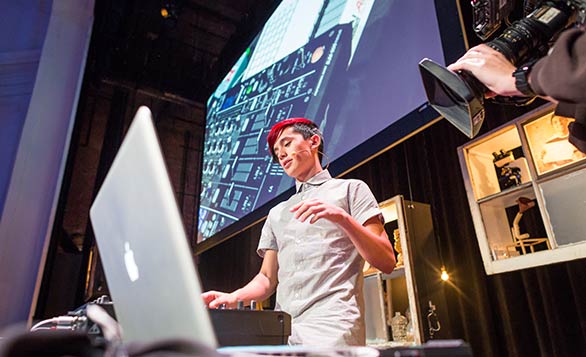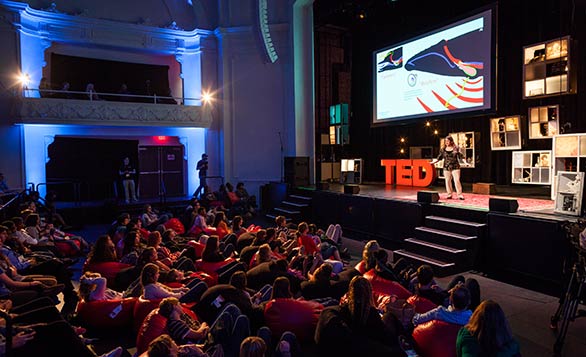By Kate Torgovnick and Thu-Huong Ha
TEDYouth is like a typical TED Conference — with its hair let down. The talks are shorter, less formal and, well, a whole lot of fun. This year’s conference was held in New Orleans and was themed around the concept, “The Spark.” Here’s a look at what happened in the first session, including thoughts on whales and their fat lips, the story of barbecue and an homage to that humble-seeming material, sand.
Comparative anatomist Joy Reidenberg studies similarities and differences in the anatomy of different species. In particular, she studies animals that live in extreme environments, in the hope of adapting their unique qualities for human applications. Her favorite animal? The whale. Reidenberg is here to tell us how whales make their unique sounds. It turns out, they fart with their faces. Excuse me? Showing awesome photos of these great mammalian beasts of the deep, Reidenberg explains: A whale takes its fat lip and rolls it over its nose to create a vibration. A system of powerful voice boxes and air sacs allow the whale to amplify the vibrations without having to breathe through its mouth or nose. That farting sound? It’s actually echolocation.
 Ron Finley: A guerrilla gardener in South Central LA
Ron Finley firmly established his motto at TED2013: “If you ain’t a gardener, you ain’t gangsta.” South Central Los Angeles’ notorious guerrilla gardener — who recently strong-armed a change in the city’s laws about planting in public spaces — is at TEDYouth to inspire young people to do something radical — to pick up their shovels and grow their own food. Why? Because it’s a way every young person can positively affect their health — and the dynamics of their communities. “You can design your own life. Don’t let some other clown do it for you,” says Finley. “Gardening is the gateway for you to design your life.”
Ron Finley: A guerrilla gardener in South Central LA
Ron Finley firmly established his motto at TED2013: “If you ain’t a gardener, you ain’t gangsta.” South Central Los Angeles’ notorious guerrilla gardener — who recently strong-armed a change in the city’s laws about planting in public spaces — is at TEDYouth to inspire young people to do something radical — to pick up their shovels and grow their own food. Why? Because it’s a way every young person can positively affect their health — and the dynamics of their communities. “You can design your own life. Don’t let some other clown do it for you,” says Finley. “Gardening is the gateway for you to design your life.”
Seventeen-year-old Cam Perron has been collecting baseball cards and writing to pro players since he was eight. So invested is he that he dug into the history of the game to discover the Negro Leagues, baseball leagues for African-Americans playing from the 1920s to the 1960s, before the game was desegregated. Later he realized that many of the Negro League players were unrecognized, undocumented and completely disconnected from the game and their old teammates. Just as outrageous, they didn’t have their own baseball cards. Perron started calling them up and found many of them wanted to share their stories. Since then he has established programs to bring together old Negro League teammates and even earn them pensions.
We’ve all heard of a family tree. But did you know this concept has a basis in science? Suzanne Simard, a professor of forestry at the University of British Columbia, shares the moment she walked through a forest and realized it was built on relationships. “Wow! Forests are just like human families,” she thought. Simard describes the incredible underground fungal network in forests that links plant to plant and tree to tree. This system grows around “mother trees,” which send nutrients down their trunks and out to their seedlings. Kind of like a human mother.
Sand is functional, gorgeous … and everywhere. It’s used in computer chips, camera sensors, silicon… The list goes on and on. And geologist Matt Kuchta can’t get enough of its endless shapes and patterns. But how do you hold up a sand structure when it’s met with wind, water or brute force? Kuchta shows a fascinating demo of how something as simple as a window screen can be used to keep sand in its place — and even be used to build a sand structure so sturdy it can hold up a bowling ball. Says Kuchta, these geofabrics are important on Earth; just imagine their applications on other planets.

Could robots work with firefighters to put out a blaze? Computer scientist James McLurkin is working to find out. Photo: Ryan Lash
James McLurkin works with robots that behave like ants or bees. A professor of computer science at Rice University, McLurkin creates multi-robot systems in which large numbers of small ‘bots work together, by sharing information and communicating with each other to achieve a big goal. Could these robots work with firefighters to put out a blaze? Or help us explore Mars? McLurkin hopes so. Here in New Orleans, he demonstrates the possibilities by showing how these robots can use distributed algorithms to organize themselves into a straight line.
Geographer Anne Knowles is really into Geographic Information Systems. Aren’t you? Knowles, who uses GIS to reimagine the past, paints a scene from American history. She challenges us to picture the fateful night of July 2, 1863, before the final day of the Civil War’s Battle of Gettysburg. Robert E. Lee, commanding the Confederate Army, is about to make a series of crucial mistakes that will cost him the war. But how did he come to make those decisions? Using “viewshed analysis,” Knowles used maps to create a simulation of what Lee had actually been able to see. This revealed that on the morning of July 3, right before Lee ordered the fateful Pickett’s Charge, he was blind to about a third of the Union Army – nearly 18,000 soldiers.
Mmm, BBQ. The fall-off-the-bone meat, the tangy sauces, the delicious mingling with the bun. Lolis Elie, best known as the story editor of the show Treme, takes the TEDYouth stage to give a history of Southern BBQ. This delicious food has been one way the many different people living in America have been able to create one culture. And yet, there are regional differences. “These traditions moved with the people,” says Elie, and yet, they’ve remained distinct, with several different styles of cooking existing side-by-side in some large cities. “It’s not e pluribus unum,” he says, quoting one of the mottos of the United States. “It’s e pluribus pluribus.”

DJ Cole Plante regularly plays to crowds of thousands. At TEDYouth, he shared tips for aspiring young DJs. Photo: Ryan Lash
Cole Plante is the perfect TEDYouth speaker for so many reasons — not least the fact that he is 16 himself. Plante grew up playing with his parents’ music equipment and now he is a well-known DJ who regularly plays for crowds of thousands. Here in New Orleans, he shares the websites aspiring young DJs should visit to learn the craft (YouTube, Beatport) and gives a look at how he layers music to create brand new sounds.

Comments (7)
Pingback: DJ prodigy Cole Plante: “Music is always there for you” | Best Science News
Pingback: Web Development & Social Media – New York Based | DJ prodigy Cole Plante: “Music is always there for you”